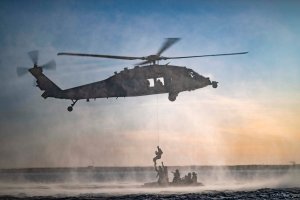

Thirty-four years after the crews of eight Army Apache helicopters fired the first shots of Operation Desert Storm, the helicopter crews were awarded Distinguished Flying Crosses for the mission, the final step in three-decade effort by their former commander to see the crews recognized.
Fifteen pilots and weapons operators were presented the awards Thursday by Army Maj. Gen. Clair Gill, the commander of the Army Aviation Center of Excellence at Fort Novosel, Alabama, at an annual convention for Army flyers in Nashville, Tennessee, according to a Defense Department release.
Known as Task Force Normandy, eight Army Apache helicopters launched from a Saudi air base toward the Iraq border in the early morning hours of Jan. 17, 1991 carrying Hellfire missiles. Led by four Air Force Pave Low helicopters that used terrain-following radar systems to keep the helicopters hidden, the Apache crews flew 90 miles into Iraqi territory to take out two of the country’s early warning radar sites, opening the skies to a massive U.S.-led bombing campaign that quickly overwhelmed the Iraqi army.
The crews originally received Air Medals with “V device” for the mission, denoting valor for flying an aerial combat mission. But behind-the-scenes efforts by the battalion commander who led the mission, retired Gen. Richard “Dick” Cody, paved the way for their award upgrades. Cody commanded the 1st Battalion, 101st Aviation Regiment, which the Apaches were assigned to.

“The eight crews of Task Force Normandy fired the first shots of Desert Storm leading to the destruction of the Iraqi radar and ground control sites and officially kickstarting the allied air campaign. Their outstanding dedication to mission accomplishment is in keeping with the finest traditions of the military, and reflects great credit upon themselves, the 101st Airborne Division (Air Assault), and the United States Army,” the award citation states.
The crews flew over the desert skies 20 minutes before H-hour, the official planned commencement for the U.S. military’s early air campaign of Operation Desert Storm.
As the helicopters drew close to the targets, totally undetected, one of the pilots gave a 10-second warning:
“Party in ten,” called 1st Lt. Tom Drew, according to a 1991 account in Air Force Magazine.
At around 2:30 a.m., the Apaches fired 27 Hellfire missiles, hundreds of rockets and thousands of 30-mm ammunition to knock out the Iraqi radars.
Starting the war
As the U.S. military contemplated how it would evict the Iraqi army from Kuwait, it focused on how U.S. bombers could reach Baghdad and other key sites inside Iraq. Planners knew the eyes and ears of the Iraqi air defense had electronic warfare radars that showed information like enemy aircraft size, direction of attack, and speed axis. Their defense system also included medium- and long-range surface-to-air missiles and short-range anti-aircraft artillery pieces, according to a large-scale combat operation analysis by Col. Paul E. Berg and Kenneth E. Tilley, both Army colonels.
“We knew that if we didn’t destroy the sites on time, the early warning sites would notify Baghdad and Saddam would know we were coming,” retired Air Force Col. Michael Kingsley, a lead 20th Special Operations Squadron pilot who flew one of the Pave Lows said at an event back in 2006.
The original attack plan named “Instant Thunder,” called for dropping Army special forces into the desert to destroy the radar sites on the ground. But planners instead opted for a mission that included MH-53J Pave Lows, embedded with GPS, as the navigators while Apache crews carried the weapons and soldiers for the attack.
The crews were named Task Force Normandy after the site of the 101st Airborne Division’s famous airborne operation on D-Day during World War II. Their 15-hour combat operation gave Navy and Air Force bombers a 20-mile-wide corridor for the ensuing air campaign at the start of Desert Storm.
“This is one of those truly significant moments for us, both as an Army and as an Aviation branch,” Gill said at the ceremony. “We need to use these example setters as people we should recognize and honor and then replicate the commitment that they made on that night of January 17, 1991.”
The latest on Task & Purpose
- Army infantry officer calls new XM7 ‘unfit for use as a modern service rifle’
- Attempted Fort Leavenworth prison break leaves military inmate tangled on fence
- When Americans, Germans and POWs fought the SS from the walls of a castle
- This Army combat medic fought off an active shooter and rendered first aid
- This 53 aircraft ‘elephant walk’ has everything you’d need for a war in the Pacific
